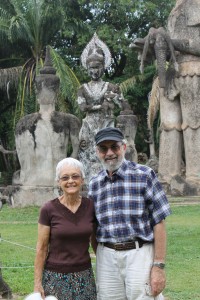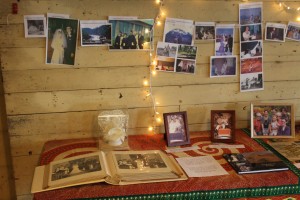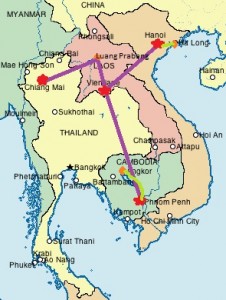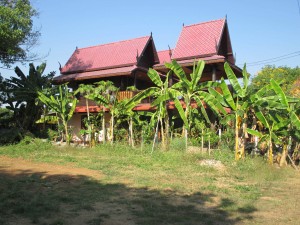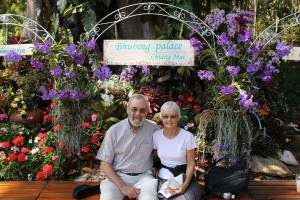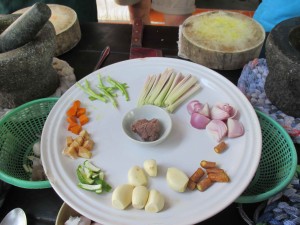Within ten days of our arrival in Laos we experienced two “baci.” (bai-si) Baci is an important ceremony practiced in Lao culture. It is a phi (spirit) ritual used to celebrate important events and occasions, like births and marriages, and also departing, beginning a new year, and welcoming. The baci is important to the Lao people as it emphasizes the importance of life and the bonds between family and friends.
Another term commonly used is su kwan. “Su” means togetherness or unity and “Kwan” means soul or guardian spirit. Ancient Lao believes that the human body has 32 organs and it is the Kwan that watches over these parts and protects them. Sometimes the Kwan may wander away from the body, causing the body to be out of balance. If the body is out of balance then a person may have illness or bad luck. The baci is performed to call the Kwan back to the body.
The two baci were celebrated by the MCC staff. The first one was to honor an MCC service worker who was returning home and also as a welcome to us. The second one was to honor three young people who have been here for a year and are returning to their respective countries—U.S. and Indonesia.
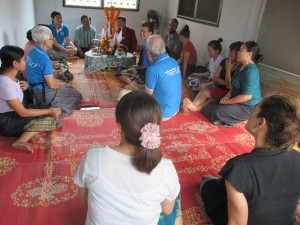
gathering
The ceremony is performed seated around a conical shaped arrangement (pha kwan) of banana leaves, flowers, and fruit from which hang white threads. (White is the color of peace, good fortune, honesty and warmth.) There are two lengths of white strings. Long strings are used for people to hold on to during the ceremony and the smaller ones are used later to tie around people’s wrists. These white cotton threads symbolize continuity and a brotherhood in the community and through tying the strings on to each others wrists it is a way to keep this community together.
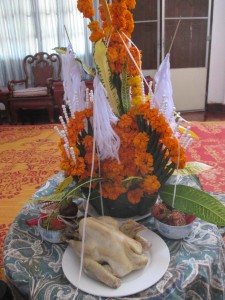
Pha Kwan with chicken and fruit
Around the base of this is the food for the kwan. The food consists usually of hard boiled eggs (symbol of the fetus), fruits and sweets symbolizing the coming together of several parts to create a community, a bottle of rice whiskey for purification, and boiled whole chicken with head and feet with claws for divination purposes.
The pha kwan is usually placed on a white cloth (though you will see a different color in our photos) in the center of the room, with the leader sitting facing the it. The person(s) for whom the baci is being held sits directly opposite of him, on the other side of the pha kwan.
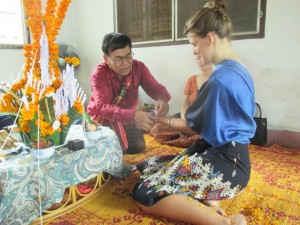
tying string on wrist
An elder/leader (ideally an ex-monk) says a long Buddhist mantra while he and guests lean in and touch the arrangement. The elder calls upon the wandering Kwan to return and inhabit the body of the person who the ceremony is intended for and to bring well-being and happiness. The elder will place an item of food into the upturned hand of the honored person. When the chanting is finished, he and others take the threads and tie them around the wrists of the honored guest(s). The strings are a symbol of binding the guardian spirits to the guests.
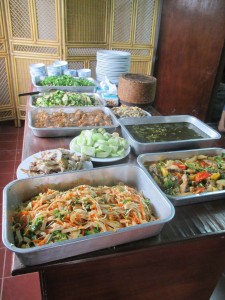
food!
Afterwards, everyone shares a meal which includes the meat of the boiled chicken of the Pha Kwan. One is supposed to keep the strings on their wrists for three days and then untie them, not cut, them. We know there is much symbolism in the ceremony which we do not understand. However, the overall, ceremony can be meaningful.
The Buddhist Lao see the baci as a part of their identity. Community is very important to Lao people and is reflected in this ceremony.
-

-
gathering
-

-
Pha Kwan
-

-
Pha Kwan with chicken and fruit
-

-
holding the strings
-

-
chanting
-

-
touching the pha kwan
-

-
touching the pha kwan
-

-
tying string on wrist
-

-
holding the fruit
-

-
strings and fruit
-

-
blessing Lena in her leaving
-

-
blessing Gloria in her leaving
-

-
food!
